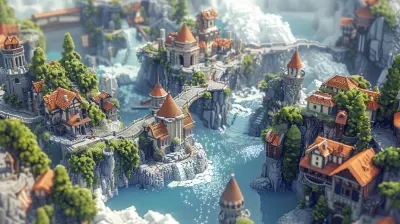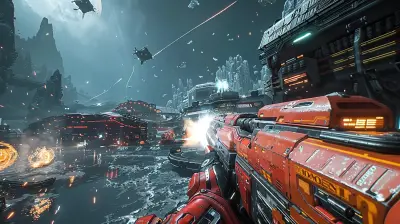Mastering Game Mechanics: A Deep Dive into Core Gameplay Design
9 October 2025
Video games have come a long way, haven’t they? From the pixelated simplicity of Pong to sprawling, immersive open worlds like Skyrim, our love affair with gaming has been fueled by one driving factor: game mechanics. At their core, game mechanics are the heartbeat of every game you’ve ever played. They’re the building blocks, the DNA, the unspoken language that connects player and experience. But what does it take to design game mechanics that captivate players and keep them coming back for more? Let’s roll up our sleeves and dive deep into the fascinating world of core gameplay design.

What Are Game Mechanics?
Before we go any further, let’s get on the same page. Game mechanics are the rules, interactions, and systems that define how a game operates. They’re what allow you to jump on platforms in Mario, loot treasure chests in Zelda, or build towering structures in Fortnite. Essentially, game mechanics are the tools and systems that guide your experience within the game.Think of game mechanics like the gears in a watch. You could have the most beautiful watch face in the world (graphics) or the catchiest chime (soundtrack), but without those internal gears keeping everything in motion, it’s just for show. Game mechanics are what make a game work. They’re the glue that holds the entire experience together.

Why Are Game Mechanics So Important?
Ever wonder why some games have you hooked for hours while others feel like a chore after ten minutes? Nine times out of ten, it boils down to the mechanics. A well-designed game mechanic can turn even the simplest concept into an unforgettable experience.Take Tetris, for instance. The mechanics couldn’t be simpler: rotate and drop blocks to clear lines. Yet it’s universally praised as one of the most addictive games of all time. Why? Because its mechanics are intuitive, balanced, and endlessly engaging.
On the flip side, poorly designed mechanics can ruin even the most promising concepts. Imagine a racing game where the cars barely respond to your input. Frustrating, right? Without smooth mechanics, the entire experience crumbles. That’s why developers spend so much time fine-tuning these systems.
The Building Blocks of Core Gameplay Mechanics
Designing game mechanics isn’t just about making a game functional—it’s about creating an experience. Here are the fundamental ideas that go into crafting mechanics that resonate with players.1. Accessibility and Intuitiveness
Have you ever picked up a controller and just known what to do? That’s the magic of intuitive design. Game mechanics should feel natural. If a player spends more time figuring out how to play instead of actually playing, you’ve got a problem.Take Portal, for example. The game introduces its core mechanic—a gun that creates portals—gradually. The first few levels act as training wheels, showing players exactly how the system works before throwing in more complex puzzles. This accessible approach invites players to experiment without overwhelming them.
2. Engagement Through Challenge and Reward
Let’s face it—games wouldn’t be fun if everything were handed to us on a silver platter. We love a challenge. But that challenge has to be balanced. If the mechanics are too easy, players lose interest. Too hard, and frustration sends them packing. Striking this balance is one of the toughest (and most rewarding) aspects of core gameplay design.Rewards, whether they’re shiny loot, new abilities, or even just the satisfaction of beating a boss, give players a reason to keep going. Think about Dark Souls. The “hard-as-nails” difficulty keeps players on edge, while the sense of accomplishment after defeating a boss is nothing short of euphoric.
3. Player Choice and Agency
Good mechanics empower players. They give you the sense that, yes, your decisions matter. Whether it’s customizing your loadout in Call of Duty, choosing your dialogue options in Mass Effect, or deciding how to approach a mission in Hitman, player agency is key.When players feel like they’re in control, the game suddenly becomes their story. They’re no longer following a script—they’re creating it. That’s the power of well-designed mechanics.
4. Feedback and Iteration
A well-designed game is constantly communicating with the player. Did your character take damage? The screen shakes. Did you land a perfect shot? The sound effect and animation tell you so. Feedback is how games “talk” to us, and it’s critical for making mechanics feel satisfying.Developers also rely heavily on iteration—tweaking and refining mechanics based on playtesting and feedback. They’re not afraid to go back to the drawing board if something isn’t working. Just like baking a cake, sometimes you have to adjust the ingredients to get the recipe just right.
The Role of Innovation in Game Mechanics
Let’s be honest. In an industry as saturated as gaming, you’ve got to bring something fresh to the table. Nobody wants to play a cookie-cutter clone of last year’s hit game. Innovation in mechanics can be the difference between a cult classic and a forgotten flop.Take Breath of the Wild. Its mechanics—like the stamina wheel, weapon durability, and physics-based puzzles—redefined what an open-world game could be. Or consider the Nemesis System in Shadow of Mordor, where enemies remember your actions and adapt to them. These innovations didn’t just make the games better—they made them unforgettable.
But here’s the kicker: innovation doesn’t mean reinventing the wheel. Sometimes, it’s as simple as putting a new twist on an old idea. It’s about asking, “How can we make this different?” while still keeping it fun.
Common Pitfalls to Avoid in Core Gameplay Design
Great mechanics might seem effortless when you’re playing, but designing them is anything but. Here are some common traps developers should avoid:1. Overcomplicating Systems
Ever play a game that bombards you with tutorials, menus, and 50 different systems before you’ve even started? Yeah, me too. Overcomplication is a surefire way to alienate players. Start small, focus on a core mechanic, and build outward.2. Ignoring Player Feedback
Game mechanics might seem perfect on paper, but players often have a way of finding their flaws. Ignoring feedback is a recipe for disaster. Developers need to listen, adapt, and iterate.3. Lack of Innovation
It’s tempting to stick with what’s safe, especially if it’s worked before. But resting on your laurels won’t capture the imagination of your audience. Don’t be afraid to take risks.The Future of Game Mechanics
As technology evolves, so too do the possibilities for game mechanics. Virtual reality and augmented reality are already pushing the boundaries of what we can do. Imagine a future where mechanics incorporate real-world physics or where AI adapts to your playstyle in real-time. The potential is mind-blowing.But at the end of the day, the best mechanics aren’t about flashy tech—they’re about human connection. They’re about creating moments that make us laugh, cry, or sit on the edge of our seats. And no matter how advanced gaming becomes, that’s something that will never change.
Wrapping It Up
Mastering game mechanics isn’t just about building systems—it’s about crafting experiences. It’s about creating a dance between the player and the game that feels seamless, rewarding, and downright fun. Whether you’re a game developer, a passionate gamer, or someone just dipping their toes into the world of design, understanding the art of core gameplay mechanics is key to appreciating what makes games tick (and click).So the next time you’re gaming, take a moment to think about the mechanics behind the magic. You might just see your favorite titles in a whole new light.
all images in this post were generated using AI tools
Category:
Game DevelopmentAuthor:

Francesca West
Discussion
rate this article
1 comments
Adam McElhinney
This article brilliantly illuminates the intricate balance between mechanics and player experience. By dissecting core gameplay elements, it emphasizes that true mastery lies not just in complexity, but in how intuitively these mechanics engage players. A thoughtful exploration that challenges developers to prioritize user-centric design.
October 9, 2025 at 4:23 AM

Francesca West
Thank you for your insightful comment! I'm glad you found the exploration of mechanics and player experience valuable. Prioritizing user-centric design is indeed crucial for meaningful gameplay.


